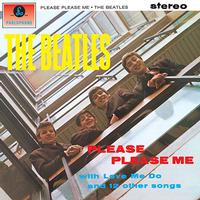The Beatles - Please Please Me
| Label: |
EMI |
| Genre: |
Pop/Rock |
| Product No.: |
AEMI 82416
|
| UPC: | 094638241614 |
| Availability: |
In Stock
|
| Category: |
180 Gram Vinyl Record |
Cut at Abbey Road studios using non-limited 24-bit digital masters sourced from the original analog master tapes!
Pressed on 180-gram vinyl; album's North American LP debut in stereo
"Love Me Do" and "P.S. I Love You" in mono
Optimum audiophile-quality sound from a first-rate team of producers and engineers
Rolling Stone 500 Greatest Albums of All Time - Rated 39/500!
For years the most anticipated vinyl reissues have been from the one, the only Beatles catalog. Finally, after a delay due to the meticulousness of the remastering process and assorted other hurdles, that day has come. The Beatles catalog is getting the audiophile treatment! 180-gram vinyl pressings cut at Abbey Road using the non-limited 24-bit digital masters sourced from the original master tapes!
Once "Please Please Me" rocketed to number one, the Beatles rushed to deliver a debut album, bashing out Please Please Me in a day. Decades after its release, the album still sounds fresh, precisely because of its intense origins. Here is the Rosetta Stone of Beatlemania, encapsulated and sounding sweeter than ever.
For its Beatles' Stereo Albums series on LP, Capitol/Apple turned to a crack team of engineers to remaster Please Please Me from the original sources. The team, including Guy Massey, Steve Rooke and Sam Okell with Paul Hicks and Sean Magee undertook a four-year restoration process for the LP versions, combining state-of-the-art equipment, vintage studio gear and rigorous testing to meet the highest fidelity standards and produce authentic unsurpassed sound rivaling the original LPs. There is no longer any need to pay hundreds of dollars for Japanese pressings!
The Beatles recorded 10 of the 14 songs on Please Please Me at EMI's Abbey Road studio in just over 12 hours on February 11, 1963. Rolling Stone, which places the album 39th on its list of the 500 greatest albums of all time, notes that for productivity alone, it's one of the greatest first albums in rock. The Beatles had already invented a bracing new sound for a rock band — an assault of thrumming energy and impeccable vocal harmonies — and they nailed it using the covers and originals in their live repertoire: the Shirelles' "Boys" and Arthur Alexander's "Anna"; the Lennon-McCartney burners "There's a Place" and "I Saw Her Standing There." Fittingly, John Lennon finished the epochal all-day session shirtless and shredding what was left of his vocal cords on two takes of "Twist and Shout."
On this remaster, for the first time you can detect the "leakage" encouraged to flow between the microphones as well as the results of the close-miking techniques designed to lighten up the sound and yet, leave it loose — hence, the explosive vocals, partially a consequence of few microphone screens or baffles. You can distinguish the Gretsch Country Gentlemen 6122 from the Rickenbacker 425 guitars. Lennon's lose-control vocal blowout on "Twist and Shout" hits a new level of wow. All due to Capitol's skillful mastering.
Extensive testing was done before engineers copied the analog master tapes into digital files using 24-bit/192 kHz resolution and a Prism A-D converter. Dust build-ups were removed from tape machine heads after the completion of each title. Artifacts such as electrical clicks, microphone vocal pops, excessive sibilance and poor edits were improved upon as long as they were judged not to damage the integrity of the songs. The 24/192 transfers were done to produce an archival copy of the tapes and then those files were reduced to 24/44.1 kHz files for final mastering. De-noising technology was applied in only a few necessary spots and on a sum total of less than five of the entire 525 minutes of Beatles music. Compression was used sparingly and only on the stereo versions to preserve the sanctity of the dynamics.
The digital files were cut to lacquers at Abbey Road Studios. Engineer Sean Magee cut the LPs in chronological release order. He used the original 24-bit remasters rather than the 16-bit versions that were required for CD production. It was decided to use the remasters that had not undergone "limiting," a procedure to increase the sound level.
Steps to eliminate vocal distortions and inner-groove distortions were addressed using a digital workstation. The latter can affect high-middle frequencies, producing a "mushy" sound noticeable on vocals. Using what Magee has described as "surgical EQ," problem frequencies were identified and reduced in level to compensate for this.
Lastly, the first batches of test pressings made from the master lacquers that had been sent to two pressing plants were judged. Records with any noise or click appearing on more than one test pressing in the same place were rejected, on the grounds that undesired sound had been introduced either during the cutting or pressing stage.
For producer Rick Rubin, The Beatles' recorded achievements are akin to a miracle. The most popular bands in the world today typically produce an album every four years, Rubin told a 2009 radio audience. That's two albums as an eight-year cycle. "And think of the growth or change between those two albums. The idea that The Beatles made thirteen albums in seven years and went through that arc of change ... it can't be done. Truthfully, I think of it as proof of God, because it's beyond man's ability."
| Side 1 | I Saw Her Standing There | Misery | Anna (Go To Him) | Chains | Boys | Ask Me Why | Please Please Me | Side 2 |
Love Me Do | P.S. I Love You | Baby It's You | Do You Want To Know A Secret | A Taste Of Honey | There's A Place | Twist And Shout |
|
View other items by The Beatles |
|
 In-Stock Music Orders Over $99 SHIP FREE Within The Continental U.S.
In-Stock Music Orders Over $99 SHIP FREE Within The Continental U.S.







 Login
Login
 My Account
My Account
 Cart
Cart Wishlist
Wishlist
 Contact
Contact





